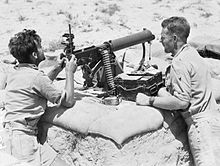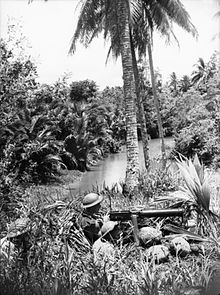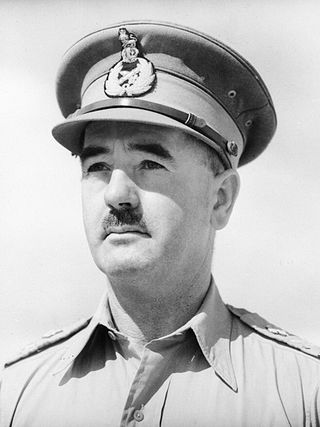
Lieutenant General Sir Leslie James Morshead, was an Australian soldier, teacher, businessman, and farmer, whose military career spanned both world wars. During the Second World War, he led the Australian and British troops at the Siege of Tobruk (1941) and at the Second Battle of El Alamein, achieving decisive victories over Erwin Rommel's Afrika Korps. His soldiers nicknamed him "Ming the Merciless", later simply "Ming", after the villain in the Flash Gordon comics.

The Second Australian Imperial Force was the name given to the volunteer expeditionary force of the Australian Army in the Second World War. It was formed following the declaration of war on Nazi Germany, with an initial strength of one infantry division and related auxiliary components. After considerable expansion of this force, three divisions were sent to the Middle East and North Africa, while the 8th Division was sent to garrison British Malaya and Singapore.

The 7th Division was an infantry division of the Australian Army. It was formed in February 1940 to serve in World War II, as part of the Second Australian Imperial Force. The division was raised on the British establishment of nine infantry battalions per division and consisted of two new brigades and three of the original 12 battalions of the 6th Division forming the third brigade. The division is sometimes known by the nickname "The Silent Seventh", due to a perception that its achievements were unrecognised, in comparison to the other Australian divisions. The origin of this belief appears to be censorship of the part played by the 7th Division in the fierce fighting in the 1941 Syria-Lebanon campaign. The 7th Division along with the 6th and 9th Australian Divisions were the only divisions to serve in both the Middle East and the South West Pacific Area. It was disbanded in 1946, following the end of the war.

The 9th Division was a division of the Australian Army that served during World War II. It was the fourth division raised for the Second Australian Imperial Force. The distinctions of the division include it being:

I Corps was an Australian Army corps, one of three that were raised by the Army during World War II. It was the main Australian operational corps for much of the war. Various Australian and other Allied divisions came under its control at different times. In 1940–1942, the corps was based in the Mediterranean and Middle Eastern theatres, and controlled forces in action against the Germans, Italians and later the Vichy French in North Africa, Greece and Syria–Lebanon.

The 9th Brigade is a Reserve formation of the Australian Army headquartered at Keswick Barracks in Keswick, South Australia, with elements located in New South Wales and South Australia. The brigade was first raised in 1912 in New South Wales following the introduction of the compulsory training scheme.
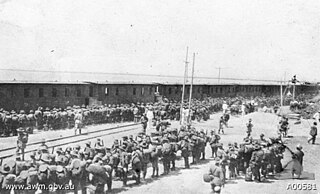
The 17th Battalion was an infantry battalion of the Australian Army. Although its numerical designation was bestowed upon it during World War I, the 17th Battalion can trace its lineage back to 1860, when a unit of the New South Wales Volunteer Rifles was raised in St Leonards, New South Wales. This unit has since been disbanded and reformed a number times. Through its links with the units of the colonial New South Wales defence force, the battalion's history includes service in the Sudan and South Africa. During World War I, the 17th Battalion was raised for overseas service as part of the Australian Imperial Force. Attached to the 5th Brigade, 2nd Division, the battalion was raised in 1915 and sent to Egypt initially, before taking part in the fighting at Gallipoli against the Turks. Later the battalion was sent to the Western Front in France and Belgium, where it served in the trenches as part of the Australian Corps. Throughout the course of the war, the battalion won numerous battle honours and its members received many individual awards, however, at the end of the war the battalion was disbanded in April 1919.

The Huon Peninsula campaign was a series of battles fought in north-eastern Papua New Guinea in 1943–1944 during the Second World War. The campaign formed the initial part of an offensive that the Allies launched in the Pacific in late 1943 and resulted in the Japanese being pushed north from Lae to Sio on the northern coast of New Guinea over the course of a four-month period. For the Australians, a significant advantage was gained through the technological edge that Allied industry had achieved over the Japanese by this phase of the war, while the Japanese were hampered by a lack of supplies and reinforcements due to Allied interdiction efforts at sea and in the air.

The 2/48th Battalion was an infantry battalion of the Australian Army which served during the Second World War. Raised in Adelaide in South Australia in August 1940, the battalion formed part of the 26th Brigade and was initially assigned to the 7th Division, although it was later transferred to the 9th Division in 1941 when it was deployed to the Middle East. While there, it saw action during the siege of Tobruk and the First and Second Battles of El Alamein before being returned to Australia to take part in the fighting in New Guinea following Japan's entry into the war.
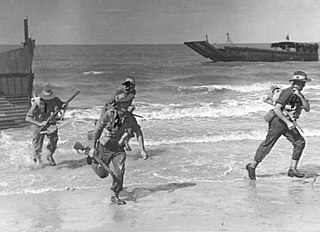
The 24th Brigade was a brigade-sized infantry unit of the Australian Army. Formed on 1 July 1940 as part of the Second Australian Imperial Force, the unit was raised for service during World War II. Originally formed as part of the 8th Australian Division the brigade was subsequently transferred to the newly created 9th Australian Division in December. The brigade served during the Western Desert Campaign, forming part of the Allied garrison during the Siege of Tobruk. Later, the brigade was withdrawn to Syria for occupation duties, but then later took part in the First and Second Battles of El Alamein. In early 1943, the brigade was returned to Australia to fight against the Japanese in the Pacific. In 1943–1944, the brigade fought in New Guinea, taking part in the landing at Lae and the Huon Peninsula campaign. Its final campaign came late in the war, when it took part in the Labuan landings and the Battle of North Borneo in mid-1945. After the war, the brigade was disbanded in early 1946.

The 20th Brigade was a brigade-sized infantry unit of the Australian Army. First raised in 1912 as a Militia formation to provide training under the compulsory training scheme, the brigade was later re-raised on 7 May 1940 as part of the all volunteer Second Australian Imperial Force for service during the World War II. The brigade was initially assigned to the 7th Division, but was later transferred to the 9th Division in early 1941. They subsequently took part in the Siege of Tobruk that year, and then the First and Second Battles of El Alamein in 1942. In early 1943, the brigade was returned to Australia to join the fighting against the Japanese in the Pacific. In late 1943, the brigade took part in the capture of Lae and then the Huon Peninsula campaign. Withdrawn to Australia in early 1944, its final campaign came during the Battle of North Borneo in the final months of the war. It was disbanded in February 1946.

The Battle of Sattelberg took place between 17 and 25 November 1943, during the Huon Peninsula campaign of the Second World War. Involving forces from Australia, the United States and Japan, the fighting centred on the Sattelberg mission station which was situated atop a hill about 900 metres (3,000 ft) above sea level, approximately 8 kilometres (5.0 mi) inland from Finschhafen, New Guinea. Following the Australian landing at Scarlet Beach a large force of Japanese had retreated inland towards Sattelberg. The Japanese, holding the high ground, subsequently threatened the Australian lines of communication as they advanced south towards Finschhafen. The Australian 26th Brigade was tasked with capturing the mission to neutralise this threat. Over the course of 10 days they advanced west from Jivevaneng up the southern approaches to the mission, reducing the Japanese position with armour, artillery, and air support. The Japanese finally abandoned Sattelberg and withdrew north to Wareo, having suffered heavy casualties and running low on supplies.

The 2/17th Battalion was an infantry battalion of the Australian Army. Raised in April 1940 in New South Wales, it formed part of the 20th Brigade, and was eventually allocated to the 9th Division. After completing basic training in Australia, the unit was deployed to the Middle East. In early 1941, it took part in the fighting at Tobruk, defending the port until relieved. A period of garrison duties followed in Syria and Lebanon before the battalion took part in the First and Second Battles of El Alamein in mid-1942. As the focus of the Australian Army's operations shifted to the Pacific theatre to fight the Japanese, the 2/17th Battalion returned to Australia early in 1943.
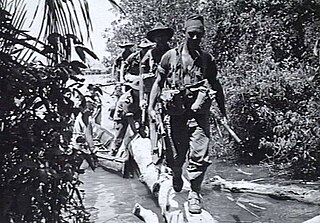
The 2/43rd Battalion was an infantry battalion of the Australian Army. Raised in July 1940 in South Australia as part of the 24th Brigade, the battalion was initially part of the 8th Division, until the 24th Brigade was re-allocated to the 9th Division in late 1940. It was with this formation that the 2/43rd saw service in the Middle East in 1941–1942, taking part in the fighting at Tobruk and in the First and Second Battles of El Alamein. It also undertook garrison duties in Syria, before returning to Australia early in 1943 to fight against the Japanese in the Pacific.
The 2/3rd Pioneer Battalion was a pioneer battalion of the Australian Army, which served during World War II. Formed in 1940, the battalion served in the Middle East where it fought in Syria and Palestine before taking part in the fighting around El Alamein. In 1943, the battalion returned to Australia and subsequently took part in the fighting against the Japanese in New Guinea in 1943–1944. Their final campaign came in mid-1945, when they took part in the Battle of Tarakan during the Borneo campaign. The battalion was disbanded in early 1946.
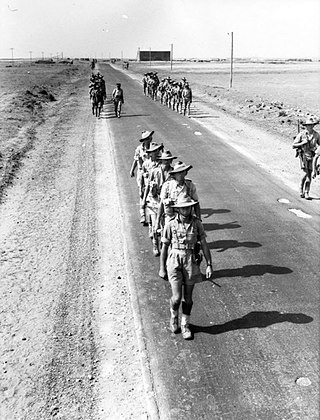
The 2/15th Battalion was an infantry battalion of the Australian Army that served during World War II. Formed in May 1940 primarily from Queensland volunteers, the battalion saw action in North Africa in 1941–1942 as part of the 20th Brigade, which was part of the 7th Division before being reassigned to the 9th Division.

The 2/24th Battalion was an infantry battalion of the Australian Army, which served during World War II. A unit of the all-volunteer Second Australian Imperial Force, it was formed in July 1940 from primarily Victorian volunteers and was known as "Wangaratta's Own" because of the time the battalion spent in the town during its formative period prior to deployment overseas. It served in North Africa in 1941–1942 as part of the 26th Brigade, which was assigned to the 7th Division, before being reassigned to the 9th Division. In early 1943, the battalion returned to Australia and later took part in campaigns against the Japanese in New Guinea in 1943–1944 and Borneo in 1945, before being disbanded in 1946. The 2/24th suffered the highest number of battle casualties of any 2nd AIF infantry battalion.

The 1st Machine Gun Battalion was an infantry support unit of the Australian Army that was raised for service during World War I as part of the all volunteer Australian Imperial Force. It was one of five such units raised as part of the AIF during the war. Formed in March 1918, the battalion consisted of four machine gun companies, which had previously existed as independent companies assigned mainly at brigade level. The battalion consisted of 64 medium machine guns, and took part in the final stages of the war, seeing action during the Allied defensive operations during the German spring offensive and then the Allied Hundred Days Offensive, which finally brought an end to the war. The battalion was disbanded in mid-1919 during the demobilisation of the AIF.
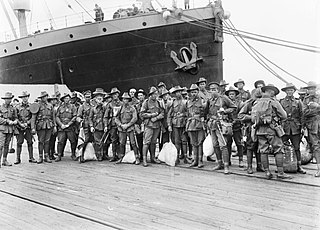
The 5th Machine Gun Battalion was an infantry support unit of the Australian Army. Originally formed in March 1918 for service during World War I as part of the all volunteer Australian Imperial Force, it was one of five such units raised as part of the AIF during the war. The battalion consisted of four machine gun companies, which had previously existed as independent companies assigned mainly at brigade level. The battalion took part in the final stages of the war, seeing action during the Allied defensive operations during the German spring offensive and then the Allied Hundred Days Offensive, which finally brought an end to the war. The battalion was disbanded in mid-1919 during the demobilisation of the AIF following the conclusion of hostilities. During World War II, the battalion was re-raised as part of the Militia in September 1942, and undertook garrison duties in the Torres Strait, until it was disbanded in May 1944.

The 3rd Machine Gun Battalion was an infantry support unit of the Australian Army. Originally formed in March 1918 for service during World War I as part of the all volunteer Australian Imperial Force, it was one of five such units raised as part of the AIF during the war. The battalion consisted of four machine gun companies, which had previously existed as independent companies assigned mainly at brigade level. The battalion took part in the final stages of the war, seeing action during the Allied defensive operations during the German spring offensive and then the Allied Hundred Days Offensive, which finally brought an end to the war. The battalion was disbanded in mid-1919 during the demobilisation of the AIF following the conclusion of hostilities.



